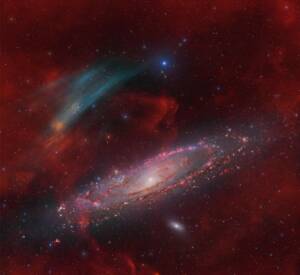
Discovery of the M31 [OIII] emission arc
Recently, a major discovery by an international team of amateur astronomers and scientists has become a huge online hit, and this new discovery is just located in one of the

Hello Kelvin, thanks for accepting our interview invitation. Congratulations on winning the ASIWEEK competition in week #28/2023!
My name is Kelvin Hennessy. I am a self-employed computer network engineer living with my wife on a small farm near the coastal town of Kingscliff in Australia. I enjoy many different aspects of photography in my spare time, particularly Astrophotography, Storm Chasing and high-speed capture of birds’ flight trails. I am also a keen road and dirt motorcycle rider.

I have been interested in Astronomy since I was a child. I took my first astrophotography video of a lunar eclipse in the year 2000 using a Sony TRV900, an advanced digital video camera for the time despite only having a resolution of 720×576. I started getting serious about Astrophotography in 2014 using a Canon 70D DSLR and the kit lens as well as an 8mm fisheye and Canon “Nifty Fifty” 50mm F/1.8. I built my own equatorial star tracker in 2015 out of Meccano.

I have a wide range of equipment as I have wanted to experiment with as many facets of Nightscape and Astrophotography as possible. My focal lengths range from 8mm when doing 360-degree spherical panoramas to 4000mm when trying to photograph planets or capture video of the space stations. I have three SkyWatcher equatorial mounts so that I can run three imaging rigs at the same time.




The air quality where I live in an elevated, coastal, semi-rural location is very good though we are rapidly being surrounded by housing estates and a new hospital, so the light pollution is getting worse. Even though we have Bortle 4 sky on the farm I prefer to travel 45 minutes to Bortle 2 sky for my imaging to reduce light pollution gradients and acquire more data for a given amount of time. I started planning a Roll-Off-Roof Observatory in 2019 and created the concrete footings. Construction costs skyrocketed so I have put that project on hold for now.

No I almost always image alone. Apart from the fact I enjoy being by myself under the stars, some imaging is very time critical and requires immense concentration, such as ISS transits of the moon, sun or planets.

I mostly use Astro Pixel Processor with final finishing in Photoshop. I do own PixInsight but am a long way from being productive with it – mostly I use it for the “Blink” process. I also purchased most of Russell Croman’s excellent Xterminator software. I agree that processing is generally the most difficult part. Acquisition is comparatively easy in my opinion, though running multiple imaging rigs doing mosaics which involves switching targets and rotating cameras for hours on end is very challenging.
My advice to beginners is to buy an equatorial tracking mount as soon as possible as I believe that is the key to getting good deep sky images that can optionally be blended with an untracked foreground to create beautiful nightscape images.

My ultra-wide panorama of the Milky Way was captured over a period of 11 months using a dual camera configuration consisting of an ASI294MC Pro coupled to a Sigma 40mm F/1.4 lens as well as a CentralDS cooled Canon 6D coupled to a Sigma 85mm F/1.4 lens. Ha and Oiii data were captured with monochrome cameras. Dual cameras allow me to capture twice the amount of image data for a given amount of time. The 90-pane mosaic is 18 mosaic panels wide by 5 panels tall with each panel being imaged for about 1 hour on average. (89.3 hours total integration time). Almost all my imaging was performed from dark sky locations to avoid light pollution gradients as much as possible. I used Astro Pixel Processor to integrate the individual panels and at the end to stitch the mosaic together.
The acquisition went smoothly however the most difficult part was trying to get Astro Pixel Processor to stitch the final 90 panels together. This mosaic is currently right at the limit of its technical capabilities. It took me over two weeks running a very fast computer almost 24 hours a day to come up with configurations settings that worked. (each mosaic registration and integration run took on average 12 hours ! ). The software developer helped me with it to the best of his ability – I even had to upgrade my computer’s SSD storage from one to two terabytes in the final stages due to the enormous working space required.


The biggest change in my opinion has been the affordability of APS-C and Full frame cooled cameras. The biggest surprise is how many well-known AstroPhotographers and Nightscapers that I used to follow no longer do it anymore.

I think that multiple cameras and wide-aperture telescopes / lenses will become more common for a couple of reasons. For competitions and awards increasingly large acquisition times are becoming more and more necessary to be competitive. Also cloud-free, moonless nights under dark skies is very valuable time, so the more data you can acquire in a night the better. I think more people will get into astrophotography because high quality equipment that gives incredible results is becoming more affordable.

ZWO ASI1600MM Pro, ASI294MM Pro, ASI294MC Pro. ASI183MC Pro (Sold)
ASI290MM mini for guiding ASI224MC second mount guiding. ASI120MC (my first ASI camera)
ZWO 7 position EFW, ZWO EAF focuser x2, ZWO 30F4 Guidescope
ASIAir Plus (unopened)

I am extremely impressed with ZWO. I think they have disrupted the astrophotography industry for the better. The cooled ASI 1600 cameras were game changers. ZWO service and support is very good. I have only had one camera sensor fail over the years and the process of sending it back to China was very highly streamlined. As someone who has dealt with technology vendors my whole working life, I know effective service when I see it.


Recently, a major discovery by an international team of amateur astronomers and scientists has become a huge online hit, and this new discovery is just located in one of the
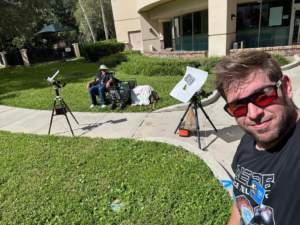
That 11-year-old boy staring at Horsehead Nebula photo would never have imagined… Decades later, he’d be capturing amazing deep-sky images from his Florida backyard! “ It was amazing to see

Hello,Sara Harvey,thanks for accepting our interview invitation. Congratulations on winning the ASIWEEK competition in week! Q1: At first, congratulation that your nice image won #ASIWEEK. Can you introduce yourself to
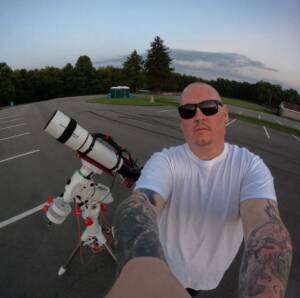
Astrophotography is more than just capturing images of the night sky—it’s a journey of discovery, patience, and creativity. For this passionate astrophotographer, what started as a chance encounter with a
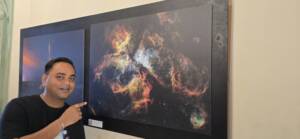
Taranjot Singh, an Indian origin Australian astrophotographer who is making waves on the international stage. Taranjot has been recognized as one of the Top 5 finalists in the prestigious Siena
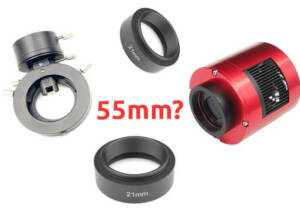
The back focal length is advised by telescope manufacturers. Since most telescopes have a 55mm back focal length, we are here to provide detailed instructions for all ASI cooled cameras.Please